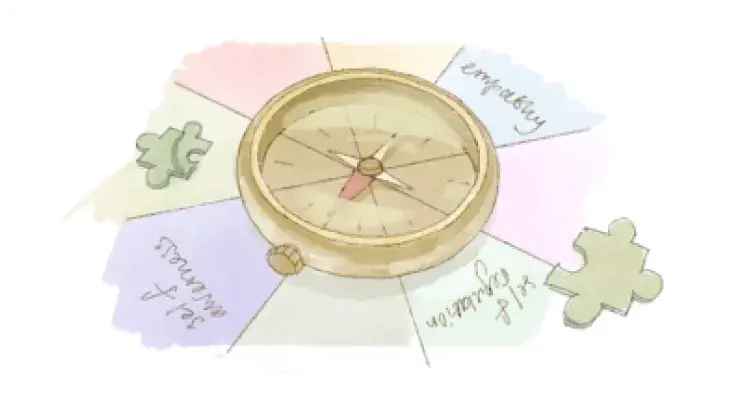Your colleague’s outbursts of anger are suspiciously similar to those of your 3-year-old son’s tantrum. Your partner has no clue why you’re so touchy about some of their jokes. You’re embarrassed by your friend choosing an absolutely unfitting outfit for an important event. All these cases have one thing in common: emotional intelligence. Or, rather, the lack of it.
Dr. Travis Bradberry, co-author of the bestseller Emotional Intelligence 2.0, emphasizes that emotional intelligence, or EI, is a crucial skill given that we have around 400 emotional experiences every single day. It helps us survive routines, communicate, adapt to change, and cope with pressures.
High emotional intelligence is about understanding ourselves better, as well as other people. It impacts our health, family and social life, and professional success.
But what does it actually mean to be emotionally aware? And are you aware of your emotions? What about the emotions of the people around you? We’ll find out further.
What is emotional intelligence?
Emotional intelligence is a person’s ability to recognize, evaluate, and control their own emotions and those of others. More precisely, according to Daniel Goleman, psychologist, author, and science journalist, EI consists of five elements or levels:
- Self-awareness
- Self-regulation
- Motivation
- Empathy
- Social skills
Researchers Mayer, Salovey, and Caruso were the first to define emotional intelligence in the 1990s, and Goleman popularized the concept through his bestselling book Emotional Intelligence: Why It Can Matter More Than IQ.
By the way, you’ve probably heard of Dale Carnegie: he nailed emotional intelligence in his legendary book How to Win Friends & Influence People, even though he did not coin the term, and he did that sixty years before Goleman.
While scientists generally agree on what EI is, experts might see differences in how best to break down its components, skills, and competencies. This brings us to several models of emotional intelligence.
Do you believe that you have high emotional intelligence?
EI models and theories
Let’s look at the three most popular models of emotional intelligence based on different scientific approaches.
1. Ability model
To be emotionally intelligent, you need to master certain skills. According to Mayer, Salovey, and Caruso, you must be aware of your emotions, make sense of them, and know how to deal with and manage them effectively. In other words, this trio of researchers claims that high emotional intelligence literally contrasts with emotional unavailability. It is essentially a mental skill that reflects a person’s ability to perceive, understand, and effectively manage emotions.
2. Trait model
This theory is anchored in personality traits. It asserts that emotional intelligence does not stem from abilities but is shaped by self-perception and emotional characteristics. This model suggests that certain people have innate emotional abilities as part of their personality structure.
3. Mixed model
Goleman blended the previous two theories. He came up with the five levels I mentioned earlier, where every level is a mix of particular cognitive abilities and personality traits. Goleman says that each of us is born with a certain level of emotional intelligence, which sets the stage for how much we can build up other mental competencies.
All these theories agree that emotional intelligence, no matter how vague and broad it may be, is indeed a scientific concept grounded in neuroscience, psychology, and biochemistry.
You probably suspect that emotional intellect matters, especially when you feel it is lacking, but how can we prove the importance of something so… subjective?
The science behind emotional intellect
It’s all in the brain.
When our ancestors huddled in caves thousands of years ago, was it their IQ that helped them survive? Hardly. Emotional awareness stems from the limbic system, which governs instincts, impulses, and intuition. It reacts first, followed by the prefrontal cortex, the brain’s rational part, jumping in. The prefrontal cortex integrates various types of information and plans and filters responses.
To survive, ancient humans relied on the feel-react-think pattern. Otherwise, a hungry predator would’ve gobbled them up as soon as they started thinking about their reaction instead of actually reacting.
Humans are hard-wired for emotional responses, even if things have changed over time. This is just how our brain works: it responds to stimuli through the activity of billions of neural connections and chemical substances that we experience as emotions.
Then, our cortex analyzes (well, ideally) these stimuli and chooses the optimal response.
Emotional intelligence is essentially a pathway between our emotional and rational minds. Focusing on intellectual skills only and neglecting the development of EI is like peering through the keyhole when the door is wide open.
Can emotional intelligence be taught?
Yes, of course. Just compare the emotional intelligence skills of a 3-year-old and an adult (we won’t take that colleague of yours into account). What’s more, one should start building emotional intelligence as early as possible.
Children are guided by the limbic system, where there is a desire, an impulse, and an immediate reaction to a stimulus. They opt for fun, instant gratification, and immediate pleasure—and throw tantrums when they don’t get what they want.
Children are easily frustrated without being able to explain why, and they can just as easily calm down again if they’re distracted just a little. This is completely normal and in line with age-appropriate stages of development.
The problems begin when an adult reacts like a child. Our prefrontal cortex (which is responsible for analysis, control, and prediction) fully matures by age 25.
So, unless they have disorders like ADHD (where the prefrontal cortex develops differently), every adult should have the physical ability to control and analyze their own emotions.
What I’m saying is that we can all be emotionally intelligent, at least when it comes to self-management. But we are not trained for it. And yes, it is only when you’re able to manage your own emotions that you can move on to empathy, social awareness, and winning people over.
So, how can you improve your emotional intelligence? My first step would be to test EQ, for example, with an EQ test from Breeze. Oh, by the way…
What does EQ stand for? Is it the same as EI?
You’ve probably come across the abbreviation EQ as opposed to IQ. EQ, meaning emotional quotient, is often used interchangeably with EI, and many companies, researchers, and authors use both terms.
I like how Dr. Shawn Andrews, a best-selling author and Forbes contributor, explains the difference: EQ is about assessment, while EI is a broader concept.
Think of EQ as a scorecard for your emotional abilities. It’s like an emotional IQ test that tells you how well you can read and handle feelings—yours and others. It’s your personal emotional report card that shows where you stand and how you can level up.
Now, EI goes beyond the numbers. It’s the full deal, covering self-awareness, keeping your cool, staying focused, understanding others, and being a social maestro. I like to think of EQ as a road map and EI as a scenic route. The EQ score guides me, but emotional intelligence creates the landscape.
And speaking of measurements and scores—things not quite typical for emotions—let’s look at what scientists have to say about assessing emotional intelligence skills.
Assessment instruments for EQ skills
Four standard tools are used to measure emotional intelligence:
1. Multi-Health Systems EQ-i 2.0
Considered a trailblazer, the EQ-i 2.0 by Multi-Health Systems is a seasoned companion in the EI journey. It offers 133 statements to test emotional intelligence and creates a comprehensive or work-performance-based report.
2. Mayer-Salovey-Caruso’s MSCEIT
The Multifactor Emotional Intelligence Scale measures four levels of the EI model: perception, usage, understanding, and management. The test consists of 141 items and provides as many as 15 scores, from general to branch and task-specific.
3. Goleman and Hay Group’s ESCI
The Emotional and Social Competency Inventory (ESCI) focuses on both social awareness and emotional intelligence, just as its name suggests. It assesses 12 competencies, four of which are in the following areas: self-awareness, self-management, social awareness, and relationship management.
4. Six Seconds SEI
This EQ test is based on the Six Seconds Model of Emotional Intelligence. It is more action-based: the tool not only assesses skills but also offers tailored frameworks for building emotional intelligence. It’s available in 24 languages and can be adapted for children and adults.
While these tools are great for in-depth assessment and training, you might prefer something easier (and free) to get started.
So, here’s how to estimate your EI level: take this short emotional intelligence test from Breeze and get the answers emailed to you in just a few minutes. Then roll up your sleeves and get to the EI building.

Improving emotional intelligence: Where to start
Travis Bradberry—I’ve mentioned him earlier—suggests the necessary basics: get your stress, sleep, and caffeine under control. Easy, right? Yeah, well, I already feel like giving up, too, but let’s take baby steps: do skip that fifth latte.
Coffee aside, you’ve probably noticed how grumpy and irritable you become when you don’t get enough sleep. Also, you are less tolerant of dad jokes, loud voices, kids’ questions, and so on.
That’s because the sleep phases you go through are vital for regulating chemicals in your brain. This includes balancing cortisol and serotonin, which directly influences your mood.
Also, poor sleep hygiene reduces social awareness: it affects the brain’s ability to accurately interpret social cues and other people’s emotions.
As for stress, it’s interesting that small doses of stress are actually beneficial for us from time to time. But prolonged or severe stress damages our mental and physical well-being.
How much is too much, you wonder? Well, if your colleague’s nail tapping drives you crazy (and never did before), you should definitely go for a walk, take a reading break, or practice gratitude.
Find out how to make your life more fulfilling with a quick & free test.
How to improve emotional intelligence on different levels
Self-awareness is your MVP. Only when you’ve taken care of yourself can you move toward improving EQ. Let’s see what you can do on all levels.
- Self-awareness. Tune into your emotions in different situations. Track them when you’re not stressed. You’ll be able to catch more subtleties when you’re thinking clearly.
- Self-regulation. Keep your cool, even in a proverbial traffic jam. Emotional self-management starts with taking a breath. Then, put on some good vibes, and navigate through challenges without going into full Hulk mode. Music, workouts, and meditation can help you here.
- Motivation. Find your driving beat—what gets you grooving out of bed? Whether it’s polishing off a project, nailing a perfect outfit, or whipping up a killer coffee (it can be decaf, you know), set that motivational vibe for every day.
- Empathy. Dance in someone else’s shoes. Take a moment to understand where the other person’s emotions are coming from, even if you’re not doing the same dance. It’s the emotional two-step that builds connection and boosts social-emotional intelligence.
- Social skills. Hit the emotional dance floor with style. It’s not just about having moves; it’s about knowing when to waltz or tango. Practice networking, collaboration, and conflict resolution to make your set of social skills complete. Understanding yourself first and others second will help you tune into the people around you, whether it’s a meeting, a party, or a charity event.
Surely, navigating through your own emotions, and especially those of other people, won’t be easy at first. But with practice, you’ll get the hang of it. So, let’s start practicing! Here are some tips on how to catch yourself making missteps.
How to check in with yourself when building EQ skills
We all stumble when the floor is uneven, when we are dizzy, or when we have not learned our steps yet. Sometimes, we can foresee and avoid this stumbling; other times, we simply have to learn our steps.
- Recognize emotional triggers (situations or people that throw you off balance). Identifying them is the first step to mastering your reactions.
- When in doubt, hit the pause button. Take a beat, reflect on your emotions, and figure out if you’re on the right track or got carried away.
- Get feedback from those around you. To build on our dancing metaphor, partners matter. Are you in sync with your partner or group? Others can give you a hint when you stumble and point toward areas for improvement.
- Learn from your mistakes and stay open to growth. High emotional intelligence requires constant work as the settings around you and your dance partners change. Mastering your emotions first will help you better adapt to scenery changes.
If you need more tips for your emotional check-ups, Breeze provides helpful guidelines for its users after they take an EQ test. And believe me, emotional intelligence is worth working on. It can become a real game-changer.
How emotional intelligence influences our lives
Learning EI skills isn’t some self-help fad—it’s a real deal that can guide you through different interactions, including those with yourself.
Let’s take marriage. A person with developed EI recognizes their partner’s feelings, picks up on non-verbal clues, and communicates with empathy. It means that when you’re stressed, your partner takes the clue from your pressed lips or tense voice and responds with empathy and care rather than frustration and impatience.
With children, emotional intelligence is crucial: you have to understand their reactions and guide them through the rollercoaster of emotions. Up to a certain age, you also need to act as their ‘external’ prefrontal cortex (responsible for analysis, control, and prediction) until your children are mature enough to take over this role for themselves.
In the professional realm, IQ surely matters. But EQ matters even more. The research conducted by TalentSmart, a consulting company co-founded by Dr. Travis Bradberry (yes, he appeared quite a few times in this article), revealed that emotional intelligence can predict performance. In fact, it’s behind 58% of successful performers across all kinds of jobs.
High EQ opens you up to a wide range of essential skills: decision-making, teamwork, presentation skills, time management, customer service, stress tolerance, assertiveness, and more. It creates a road to leadership where being smart is not enough.
And then comes relentless work on personal growth. Emotional intelligence is your backstage pass to being self-aware, recognizing your quirks, and working on becoming your best self.
Are you ready to start this journey with Breeze?
Final thoughts
Here’s one simple reason why you should bother with emotional intelligence: it’s your ticket to acing life’s dance moves, from romantic relationships to career partnerships. Having high EI skills means you’re the DJ of your own vibes, rocking at self-management and connecting with people on a personal level.
Emotional intelligence isn’t a fixed trait; it’s a journey. Spotting triggers early on, hitting pause for self-reflection, getting feedback, and learning from your oopsie-daisy moments—those are the moves that level up your emotional game. And in a world where you’re barraged with emotions every single day, boosting your EQ isn’t just a nice-to-do—it’s a must.
So, as you kickstart this journey, remember that high EQ can give you the superpower to not just follow the beat but to lead the whole dance floor with flair and authenticity.
Joy Ismail, PhD, shared her insightful ideas on emotional intelligence: “Humans are inherently social beings—there’s no getting around it. Having emotional intelligence can greatly enhance our interactions because it allows us to accurately perceive emotional states and engage in effective communication and resolution. Emotional intelligence is a crucial toolkit that—when mastered—can boost feelings of happiness. As with all other skills, emotional intelligence can be built over time with effort and energy until it becomes reflexive. Practice is key.”
Disclaimer
This article is for general informative and self-discovery purposes only. It should not replace expert guidance from professionals.
Any action you take in response to the information in this article, whether directly or indirectly, is solely your responsibility and is done at your own risk. Breeze content team and its mental health experts disclaim any liability, loss, or risk, personal, professional, or otherwise, which may result from the use and/or application of any content.
Always consult your doctor or other certified health practitioner with any medical questions or concerns
Breeze articles exclusively cite trusted sources, such as academic research institutions and medical associations, including research and studies from PubMed, ResearchGate, or similar databases. Examine our subject-matter editors and editorial process to see how we verify facts and maintain the accuracy, reliability, and trustworthiness of our material.
Was this article helpful?




